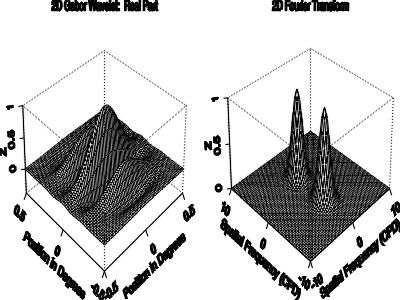Next: Doubly Dimensionless Projected Polar Up: Image Analysis Previous: Assessing Image QualityEyelid
![]()
![]()
![]()
Next: Doubly Dimensionless Projected Polar Up: Image Analysis Previous: Assessing Image QualityEyelid

Figure 2: The real part of a 2-D Gabor wavelet, and its 2-D Fourier transform. From
Daugman (1980) [8].
An effective strategy for extracting both coherent and incoherent textural information from images, such as the detailed texture of an iris, is the computation of 2-D Gabor phasor coefficients. This family of 2-D filters were originally proposed in 1980 by Daugman [8] as a framework for understanding the orientation-selective and spatial-frequency-selective receptive field properties of neurons in the brain's visual cortex, and as useful operators for practical image analysis problems. Their mathematical properties were further elaborated by the author in 1985 [9], who pointed out that these 2-D quadrature phasor filters were conjointly optimal in providing the maximum possible resolution both for information about the orientation and spatial frequency content of local image structure (in a sense ``what"), simultaneously with information about 2-D position (in a sense ``where"). The complex-valued family of 2-D Gabor filters uniquely achieves the theoretical lower bound for conjoint uncertainty over these four variables, as dictated by an inescapable uncertainty principle [9].
These properties are particularly useful for texture analysis [2], [4]-[7], [10], [14]-[16], [18], [23], [29]-[31] because of the 2-D spectral specificity of texture as well as its variation with 2-D spatial position. A rapid method for obtaining the required coefficients on these elementary functions for the purpose of representing any image completely by its 2-D Gabor Transform, despite the non-orthogonality of the expansion basis, was given in [10] through the use of a relaxation neural network. A large and growing literature now exists on the efficient use of this non-orthogonal expansion basis and its applications (e.g. [2],[14],[23],[28]).
Two-dimensional Gabor filters over the image domain (x,y) have the functional form
where (xo,yo) specify position in the image, (![]() ,,
,,![]() ) specify effective width and length, and (uo,vo) specify modulation, which has spatial frequency
) specify effective width and length, and (uo,vo) specify modulation, which has spatial frequency ![]() o = (uo² + vo²) ½ and direction
o = (uo² + vo²) ½ and direction ![]() o = arctan( vo/uo). (A further degree-of-freedom included below but not captured above in
(5) is the relative orientation of the elliptic Gaussian envelope, which
creates cross-terms in xy.) The 2-D Fourier transform F(u,v) of a 2-D Gabor filter has exactly the same functional form, with parameters
just interchanged or inverted [9]:
o = arctan( vo/uo). (A further degree-of-freedom included below but not captured above in
(5) is the relative orientation of the elliptic Gaussian envelope, which
creates cross-terms in xy.) The 2-D Fourier transform F(u,v) of a 2-D Gabor filter has exactly the same functional form, with parameters
just interchanged or inverted [9]:
The real part of one member of the 2-D Gabor filter family, centered at
the origin (xo,yo) = (0,0)and with aspect ratio (![]() /
/![]() ) = 1 is shown in Figure 2, together with its 2-D Fourier transform F(u,v).
) = 1 is shown in Figure 2, together with its 2-D Fourier transform F(u,v).
2-D Gabor functions can form a complete self-similar 2-D wavelet expansion
basis [10], with the requirements of orthogonality and strictly compact
support [20]-[21] relaxed, by appropriate parameterization for dilation,
rotation, and translation. If we take ![]() (x,y) to be a chosen generic 2-D Gabor wavelet, then we can generate from this
member a complete self-similar family of 2-D wavelets through the generating
function
(x,y) to be a chosen generic 2-D Gabor wavelet, then we can generate from this
member a complete self-similar family of 2-D wavelets through the generating
function
where the substituted variables (x',y') incorporate dilations of the wavelet in size by 2 to the power -2m, translations in position (p,q), and rotations through angle Ø:
It is noteworthy [9] that as consequences of the similarity theorem, shift
theorem, and modulation theorem of 2-D Fourier analysis, together with the
rotation isomorphism of the 2-D Fourier transform, all of these effects
of the generating function (7) applied to a 2-D Gabor mother wavelet ![]() (x,y) =G(x,y)in order to generate a 2-D Gabor daughter wavelet
(x,y) =G(x,y)in order to generate a 2-D Gabor daughter wavelet ![]() mpqØ have corresponding or reciprocal effects on its 2-D Fourier transform F(u,v) without any change in functional form. This family of 2-D wavelet filters
and their 2-D Fourier transforms is closed under the transformation group
of dilations, translations, and rotations [9]. We will exploit these self-similarity
properties of 2-D Gabor filters in analyzing iris textures across multiple
scales to construct identifying codes.
mpqØ have corresponding or reciprocal effects on its 2-D Fourier transform F(u,v) without any change in functional form. This family of 2-D wavelet filters
and their 2-D Fourier transforms is closed under the transformation group
of dilations, translations, and rotations [9]. We will exploit these self-similarity
properties of 2-D Gabor filters in analyzing iris textures across multiple
scales to construct identifying codes.
![]()
![]()
![]()
Next: Doubly Dimensionless Projected Polar Up: Image Analysis Previous: Assessing Image QualityEyelid